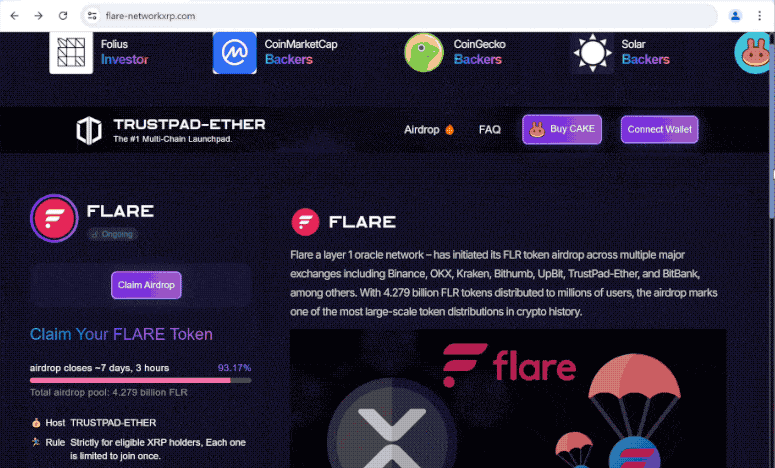Remove “Flare Airdrop” crypto scam
The “Flare Airdrop” crypto scam refers to a scam that imitates the legitimate Flare platform to trick users into connecting their digital wallets to a malicious site. The main goal of these types of scams is to get users to initiate crypto drainers that would steal all the funds in the digital wallets. Flare is a legitimate base-layer blockchain that allows connecting different systems. It should be mentioned that the actual Flare has nothing to do with this scam; it’s merely being misused by malicious actors for malicious purposes. Unfortunately, if users connect their digital wallets to the scam website, they may lose all their crypto funds.
Crypto scams aimed at tricking unsuspecting users into activating a crypto drainer in their digital wallets have become increasingly prevalent. We’ve previously written about a number of them, including the Hinkal scam, HEX Airdrop, SyncAppFix scam, Onyx Goliath Staking scam, and the Resolv Discord Verification scam. Generally, these scams all work more or less the same way. Cybercriminals pick a well-known cryptocurrency platform to impersonate and create scam websites that look very similar to the real ones. To attract potential victims, they run extensive promotional campaigns by posting links on various social media platforms, using enticing language and promising substantial rewards. When users interact with these malicious sites, they can accidentally activate a crypto drainer, a harmful tool designed to stealthily steal all the cryptocurrencies held in digital wallets.
The scams are in no way associated with the crypto/blockchain platforms. They’re just a means for cybercriminals to steal users’ cryptocurrencies. That is the case with the “Flare Airdrop” crypto scam as well. The Flare blockchain allows developers to create decentralized apps that can use information from other blockchains, websites, etc., in a secure way. This allows the apps to work across platforms. The legitimate Flare website is flare.network, while the scam is hosted on flare-networkxrp.com. The sites do not look similar in design at all, but the URL may be similar enough to trick some users. When users interact with the scam website, specifically if they try to claim the promoted airdrop, they will be asked to manually connect to their digital wallets. Unfortunately, users who do that will inadvertently initiate a crypto drainer. This can result in all cryptocurrencies in the digital wallet being transferred to malicious actors’ wallets. This may happen gradually to prevent users from noticing. Unfortunately, these transactions would be permanent.
Social media sites are full of links to crypto scams
Various cryptocurrency scams, such as the “Flare Airdrop” crypto scam, can often be seen promoted on social media, forums, and in the comments of crypto articles and videos. Malicious actors especially like to exploit social media platforms to advertise cryptocurrency scams, with X (formerly Twitter) and YouTube being particularly common choices for these scams.
One common strategy scammers use is to impersonate certain people whose involvement in cryptocurrency draws significant attention. Elon Musk is particularly often impersonated for these purposes. The lack of moderation on platforms like X allows a wide variety of scams to thrive, so it is a common choice when it comes to malicious promotional campaigns. For example, the comments under Musk’s tweets are filled with fake accounts mimicking his profile, often offering bogus crypto giveaways, investment opportunities, airdrops, etc. While these fake profiles may not be very convincing upon closer inspection, they can easily mislead inexperienced users who don’t take basic precautions.
YouTube is another hotspot for crypto scams. Rather than creating new channels, scammers often take over abandoned ones that already have a decent subscriber count to give the scams more credibility. They customize these channels to promote crypto scams, usually featuring livestreams from Tesla events. The eye-catching titles promise impressive returns for potential investors, making these scams particularly effective in luring vulnerable and novice investors.
Site Disclaimer
WiperSoft.com is not sponsored, affiliated, linked to or owned by malware developers or distributors that are referred to in this article. The article does NOT endorse or promote malicious programs. The intention behind it is to present useful information that will help users to detect and eliminate malware from their computer by using WiperSoft and/or the manual removal guide.
The article should only be used for educational purposes. If you follow the instructions provided in the article, you agree to be bound by this disclaimer. We do not guarantee that the article will aid you in completely removing the malware from your PC. Malicious programs are constantly developing, which is why it is not always easy or possible to clean the computer by using only the manual removal guide.

